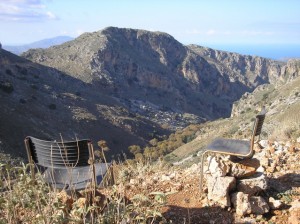
Describing the route from Mesavlia to Malathiros (Walk 3 in our book ‘More Walks from Paleohora’, see below), we note that “the hill to the right has ruined stone walls encircling its summit, and was probably fortified at some point in its history.”
That was in 2003. Now there’s a board at the foot of the hill, indicating a footpath to the Byzantine Castle above.
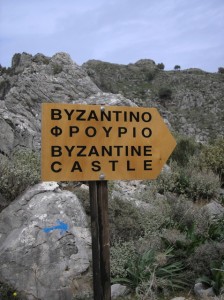
The walk there and back from Mesavlia, with an ascent of the hill and exploration of the site makes for a pleasant autumn afternoon, and will fit in with the Ktel bus timetable. Take the 12.00pm Chania bus from Paleohora to Mesavlia, asking to alight at the sign for the gorge, just before the village. If driving (31km) turn down this road for 200m and park by the bridge.
Mesavlia is a scattered village, little of which can be seen from the main road. Cross the bridge and walk along the road, through several clusters of houses, and after 1km reach the fork where a track leads down right into the gorge. Avoid this and continue ahead, as the track climbs, passes an animal enclosure, levels out then falls, bending left to the col below the ‘castle’.
On the way, keep an eye out for the enormous griffon vultures almost always seen here, either circling above the gorge, or on the cliff ledges where they nest. Last February Lynne and I watched as two huge adult birds, with a wing span of around three metres, suddenly flew off from the carcass of a goat, just below the track. An awesome sight, and a little frightening!
From the sign/notice on the col, there’s a climb of 100 metres to the summit above at 602m.
Initially there is a path with blue waymarks, which soon give out, so look carefully for the feint path as it winds upwards, veering right.
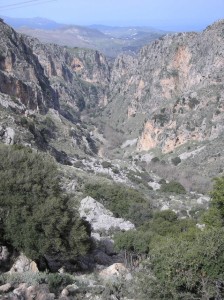
The gorge from below the castle track
Go through a wire ‘gate’, then up a gully below a wall, using hands where necessary as the ‘path’ steepens. Eventually, leading back left, pass through an enclosing wall, close to one of three ‘sentry/lookout posts’ and into the ‘castle’.
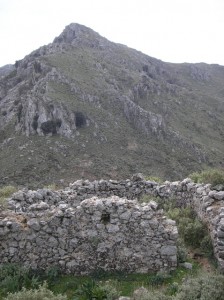
Castle lookout
A pleasant hour or more can be spent exploring the site and enjoying the views. Although it’s over rough ground and boulders, try to reach the summit, where there appears to be the remains of a well close to the concrete trig pillar. And keep a close watch on children, as there are fearsome drops into the Deliana/Mesavlia Gorge, some 250m below. Just when the ‘castle’ was built is open to speculation and conjecture. The Byzantine era dates from AD 330-1204, a period of 874 years, although between AD 824/961 Crete came under Arab rule. After 1204 the island was occupied by the Venetians and later by others …..
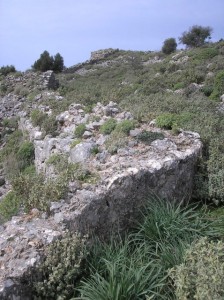
Castle walls
As with the Dorian site at Kadros (see ‘Explore’ September 2009) it’s fascinating to sit among the ruins, and try to imagine the scene here many centuries ago. The site would certainly have been an almost impregnable fortress during the many troubled times Crete has witnessed.
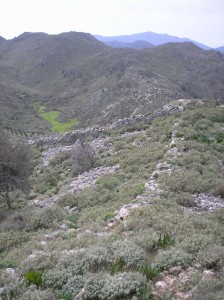
Byzantine walls
The views, if you’ve chosen a clear day for the climb, are quite outstanding. Below to the north lies Kissamos Bay between the arms of Gramvousa and Rodopou peninsulas. More distant are the White Mountains, and beyond Chania is the Akrotiri peninsula. If you know where to look, you can pick out the Sassalos, Topolia and Sirikari gorges, all to the west.
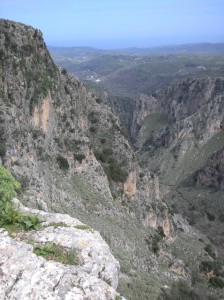
View into Mesavlia Gorge and beyond from the Castle
Take your time on the descent back to the col, from where it’s 2km back to the starting point. The bus (the last of the day!) leaving Chania at 4.15pm will pass around an hour later, but better to be sitting by the wooden bus shelter at 5.00pm, just in case it’s early.
‘More Walks from Paleohora’ on sale (€10) at ‘To Delfini’ bookshop in the village centre.


Recent Comments